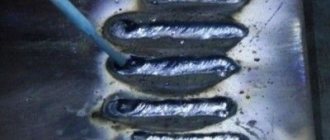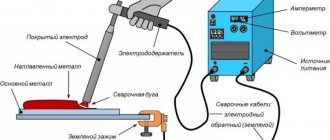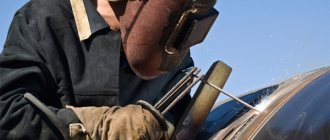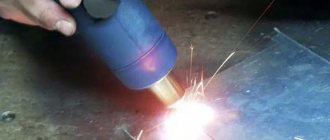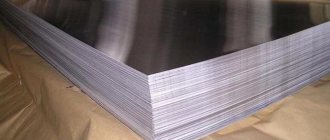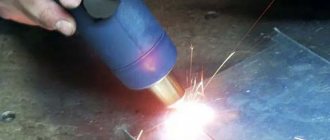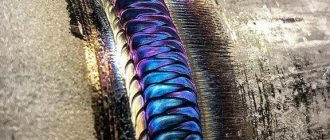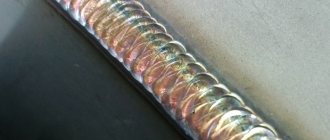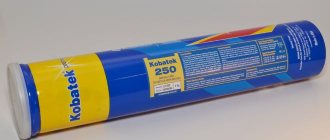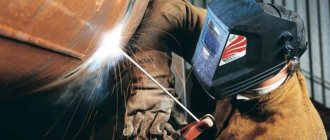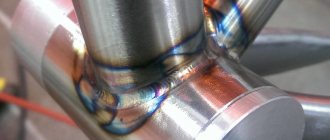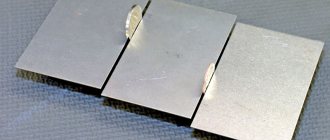Plasma welding will increase efficiency and also reduce the time required for metal cutting. Devices for this type of welding are gaining increasing popularity among equipment used for plasma welding. You can watch the video by following the link on our website.
Many companies around the world are developing this market segment, producing both the devices themselves and related accessories. It also released its devices in Russia, which in all respects are worthy competition to foreign ones. Welding is carried out by machines, some of which are capable of cutting.
What is plasma welding
The emergence of new types of metal alloys in modern technologies has forced specialists to develop new techniques and drawings of equipment for welding products made from them. Since many modern metals do not lend themselves well to traditional welding techniques. As a result, a new plasma method for welding metal samples has emerged, which is successfully used in various repair and installation processes.
The main differences between plasma welding technology
Plasma welding is somewhat reminiscent of argon welding, but there are characteristic differences. For example, it has an operating temperature that is much higher. The welding arc can have a temperature from 5 to 30 thousand degrees. Thanks to this quality, using plasma welding technology, it is possible to connect elements of building structures that cannot be welded with homemade and standard factory equipment, the arc temperature of which does not exceed 5 thousand degrees.
Operating principle of plasma welding
The essence of this welding: by exposing the metal surface to a flow of ionized gas conducting an electric current, the metal melts. When the arc is heated, the gas undergoes ionization, the level of which increases with increasing gas temperature. A plasma jet, which is characterized by ultra-high temperature and increased power, is formed from an ordinary arc after compression, injection into the arc formed by a plasma-forming gas, which is usually argon (hydrogen and helium are rarely used).
The kinetic energy of the chemical elements present in the gas during the ionization process significantly increases the thermal energy of the plasma arc. Moreover, the arc, when compared with a conventional one, has the ability to significantly increase the pressure on the metal surface due to a decrease in its own diameter.
Practical implementation
Schematic diagram of a plasma welding machine.
Often, when making a homemade plasma welding machine, the nozzle is machined from copper. If there is no alternative, this option is possible, but the nozzle becomes a consumable even when only a standby current passes through it. It will have to be changed frequently. If you can get a small piece of molybdenum or tantalum round timber, it is better to make a nozzle from them. Then you can limit yourself to periodic cleaning.
The size of the central hole in the nozzle is selected experimentally. You need to start with a diameter of 0.5 mm and gradually bore it to 2 mm until the plasma flow is satisfactory.
The nozzle is screwed into a hollow cooling jacket, which is connected to the central electrode holder through a fluoroplastic insulator. Coolant circulates in the cooling jacket. As such, in the warm season you can use distilled water; in winter, antifreeze is better.
Diagram of the control unit of a plasma welding machine.
The cooling jacket consists of 2 hollow copper tubes. The inner one with a diameter and length of about 20 mm is located at the front end of the outer tube with a diameter of about 50 mm and a length of about 80 mm. The space between the ends of the inner tube and the walls of the outer tube is sealed with thin sheet copper. Copper tubes with a diameter of 8 mm are soldered into the jacket using a gas torch. Coolant flows in and out through them. In addition, a terminal must be soldered to the cooling jacket to supply a positive charge.
A thread is made in the inner tube into which a removable nozzle made of heat-resistant materials is screwed. An internal thread is also cut at the extended end of the outer tube. An insulating ring made of fluoroplastic is screwed into it. The central electrode holder is screwed into the ring.
An argon supply tube of the same diameter as for cooling is soldered through the wall of the outer tube into the space between the cooling jacket and the fluoroplastic insulator.
Liquid from the windshield wiper reservoir circulates through the cooling jacket. Power is supplied to the pump of its electric motor through a separate 12 V rectifier. There is already an outlet for the supply on the tank; the liquid return can be cut through the wall or lid of the tank. To do this, a hole is drilled in the lid and a piece of tube is inserted through the pressure seal. Rubber hoses for liquid circulation and argon supply are connected to their tubes with clamps.
Scheme of plasma powder fusion.
The positive charge is taken from the main power source. A suitable electronic ballast is selected to limit the current through the nozzle surface. The supplied electric current must have a constant value in the region of 5-7 A. The optimal current value is selected experimentally. This should be the minimum current that ensures stable combustion of the pilot arc.
The pilot arc between the nozzle and the tungsten cathode can be excited in one of two ways. Using an oscillator built into the welding machine or, in the absence of one, using a contact method. The second option requires a more complex design of the plasma torch. During contact excitation, the central electrode holder is made spring-loaded relative to the nozzle.
When the rubber button of the rod connected to the electrode holder is pressed, the sharp end of the central tungsten cathode contacts the conical surface of the rod. During a short circuit, the temperature rises sharply at the point of contact, which allows an arc to be initiated when the cathode is pulled away from the anode by a spring. The contact must be very brief, otherwise the surface of the nozzle will burn.
Excitation of current by a high-frequency oscillator is preferable for the durability of the structure. But purchasing it or even manufacturing it makes a homemade welding machine for plasma welding unprofitable.
During operation, the positive terminal of the welding machine is connected to the part without ballast. When the nozzle is within a few millimeters of the workpiece, electrical current is switched from the nozzle to the workpiece. Its value increases to that set on the welding machine, and the formation of plasma from argon intensifies. By adjusting the argon supply and welding current, you can achieve the required intensity of plasma flow from the nozzle.
Advantages of plasma technology
- Unlike gas welding, the cutting speed of metal 5-20 centimeters thick using the plasma method is three times higher.
- The high precision of the seams obtained as a result of melting and welding of metal, the quality of the work performed practically eliminates the need for subsequent processing of the edges of the products.
- Plasma cutting is used to process almost any type of metal. For example, you can cook samples from Zaporozhye steel, cast iron, copper, aluminum.
- When welding, the metal is not subject to deformation even when it is necessary to cut out complex shapes. The plasma welding technique makes it possible to cut on an unprepared metal surface, for example, rusty or coated with a layer of paint. In this case, the paint in the working area of the plasma arc does not ignite.
- There is no need for argon, acetylene, or oxygen. This significantly reduces financial costs.
- High degree of safety of work, since gas cylinders are not used. This indicator indicates the environmental friendliness of the process.
Specifications
Plasma cutting of metals provides the following technical characteristics:
Thickness of sheets and blanks. To process workpieces of different thicknesses, the current strength, gas flow rate and distance between the electrodes are adjusted. This parameter significantly depends on the thermal conductivity of the metal: as it increases, the thickness decreases and vice versa. Small portable machines are capable of cutting metals up to 10-12 mm thick, and powerful equipment - up to 100 mm
It is important to consider that plasma cutting is effective when cutting steel workpieces with a thickness of no more than 50-60 mm, aluminum sheets - up to 120 mm, copper products - up to 80-85 mm, and cast iron - up to 90 mm. Special combined equipment provides cutting of metals up to 200 mm thick. Complex, shaped cutting is performed with workpiece thicknesses up to 100 mm. Sheet sizes
They depend on the dimensions of the machine’s work table. The modern equipment used allows processing sheets with a width of 2.5–3 m (gantry machines - up to 4 m) and a length of 4–5 m (large-sized machines - up to 6-7 m). Sheet movement speed. It depends on the shape of the workpiece and the thickness of the sheets. The speed of sheet movement is usually adjustable within the range of 50–800 mm/min. Modern CNC equipment is capable of cutting thin sheets at speeds of up to 20,000 mm/min. Most often, the following modes are set: for sheets up to 100 mm - up to 5000 mm/min, for shaped cutting - about 200–250 mm/min. Cutting angle. Most often, plasma cutting is used for perpendicular cuts. Without increasing the quality of the edges, the angle may deviate from perpendicular by 20–50°. Roughness. In the cutting zone it is standardized by GOST and can correspond to classes 1,2 or 3.
Complex, shaped cutting is performed with workpiece thicknesses up to 100 mm. Sheet sizes. They depend on the dimensions of the machine’s work table. The modern equipment used allows processing sheets with a width of 2.5–3 m (gantry machines - up to 4 m) and a length of 4–5 m (large-sized machines - up to 6-7 m). Sheet movement speed. It depends on the shape of the workpiece and the thickness of the sheets. The speed of sheet movement is usually adjustable within the range of 50–800 mm/min. Modern CNC equipment is capable of cutting thin sheets at speeds of up to 20,000 mm/min. Most often, the following modes are set: for sheets up to 100 mm - up to 5000 mm/min, for shaped cutting - about 200–250 mm/min. Cutting angle. Most often, plasma cutting is used for perpendicular cuts. Without increasing the quality of the edges, the angle may deviate from perpendicular by 20–50°. Roughness. In the cutting zone it is standardized by GOST and can correspond to classes 1,2 or 3.
The machines used provide high accuracy and high-quality cutting regardless of thickness by adjusting the parameters of the plasma flow. Does not affect the quality and presence of paint and other protective coatings (for example, galvanizing), as well as dirt and dust.
Types of plasma welding
Depending on the tools used, plasma welding can be:
- on currents of any polarity;
- with penetrating/non-penetrating arc;
- point, pulse;
- automatic, semi-automatic, manual;
- with and without filler wire.
In the case of using low currents, the connection technique is called microplasma, which is the most popular. This scheme is in demand in the production of structures up to 1.50 mm thick - this is usually the connection of thin-walled pipes, containers, welding of small elements to heavy structures, the manufacture of jewelry, thermocouples, as well as welding of foil samples. Thin-walled metal products are also welded using electric rivets.
If the connection is made using filler wire, then solid wire (cored wire) is used.
Purpose of the manipulator
In addition to rotators, there are other types of additional welding equipment - tilter, positioner, manipulator. It is worth talking in particular detail about manipulators, because they are most often used in production and at home.
The manipulator can move or rotate the part in any direction that is necessary for welding work. It is more versatile than a spinner.
A significant advantage of modern manipulators is their ease of readjustment. If desired, it is not difficult to adjust the operation of such devices.
To do this, you just need to reconfigure the software, that is, change the working program, after which the tool will begin to move along a new trajectory. The connection line or seam line in this case will also undergo changes.
The modular design of most manipulators common today allows you to easily change the orientation of the working tools. As a result, the same device can be used in different welding technologies.
Features of microplasma connection
Plasma welding comes in three options, depending on the current used during operation:
- microplasma welding technology on currents - 0.1A-25A;
- connection with medium currents - 25A-150A;
- connection with high currents - 150A and above.
The first variation is more popular. In the process of connecting metal samples using a low-ampere current, a pilot arc is formed. It burns uninterruptedly between a water-cooling nozzle made of copper and a two-millimeter cross-section tungsten electrode.
The main arc is formed after bringing the plasmatron to the surface of the metal sample being processed. The gas that forms the plasma is supplied through a plasma nozzle, the diameter of which can be 0.5-1.5 millimeters.
The maximum diameter of the plasma arc is 2 millimeters. Thanks to this indicator, quite a large amount of thermal energy is generated on a relatively small element of the workpiece. This type of welding, like welding with electric rivets, is most effective for metal samples whose thickness is less than 1.5 millimeters.
Argon is used to form plasma, a protective gas environment, using this technology. Depending on what metal or alloy the sample is made of, additives can additionally be used to increase the efficiency of the “plasma”.
A plasma welding machine is capable of joining metal products in different modes. The range of welding uses is quite extensive:
- fastening membranes to large-scale structures;
- production of thin-walled pipes and containers;
- welding foil;
- jewelry manufacturing;
- many other connections.
Schematic diagram of the device
A typical drawing of a homemade plasma cutter shows the following elements:
- Electrode. This component receives voltage from the power supply, due to which the gas environment is ionized. To produce the rod, refractory metals are used - titanium, hafnium, zirconium.
- Nozzle. The unit allows air to pass through and creates a directed stream of ionized gas.
- Cooler. Removes heat from the nozzle, preventing overheating of the plasma torch.
We recommend reading: How to choose a gasoline welding generator
The device, assembled according to a standard scheme, has the following operating principle:
- Pressing the “Start” button turns on the relay. It supplies electricity to the control unit.
- The second relay directs current to the inverter. After this, the burner purge system is turned on. A powerful air stream enters the chamber, cleaning it.
- The oscillator is activated, which ionizes the working gas circulating between the anode and cathode. At this stage, the primary arch appears.
- When the torch is brought close to the metal, a discharge occurs. A cutting arc is formed.
- Using a reed switch, the ignition current supply is turned off. If the cutting arc disappears, it is resumed.
- After cutting is completed, the relay turns on the compressor. The air it pumps cools the nozzle and removes metal combustion products.
DIY welding
This type of metal welding was not initially used at home, as it required a highly qualified welder. Today, thanks to the improvement of the methodology itself and the equipment used, there are welding units that can be used at home. The working method is very simple. To perform welding work, you need to purchase the appropriate equipment, filler wire, electrodes, and read the operating instructions for the device.
Tips for Beginners
- The electrode must first be sharpened to a cone-shaped shape, and the sharpening angle should be a maximum of 30 degrees.
- Important! Correct installation of the electrode. Its axis must coincide with the axis of the nozzles for gas formation.
- The welding joint is subjected to similar processing as when welding with argon.
- It is imperative to clean and then degrease the edges of the workpiece.
- It is necessary to ensure that there are no gaps larger than 1.5 millimeters.
- Additionally, the tack areas are cleaned; they must be of the same quality as the weld.
- You can start welding work.
- Do-it-yourself welding is carried out using direct current. Its value must be within the specified range.
- Before welding the samples, gas is supplied 10-15 seconds, which is turned off after 15 seconds after the arc breaks.
- During operation, the plasma torch should be located from the workpiece at a distance of less than one centimeter.
- It is recommended to hold the welding arc until the seam connection is completely completed.
- Do not overheat the metal during welding. After reaching the critical point, welding is suspended, the metal sample is cooled, after which welding work can be resumed.
- The gun (torch) must be moved evenly, then you can count on obtaining a high-quality welded joint.
What does it consist of?
A plasma welding machine consists of several components: a power source, a special welding torch, a cathode and cable packages. Let's take a closer look at them.
Power supply
The previous generation plasma welding machine used a conventional transformer as a power source. Such a source itself was rather large and heavy, and therefore significantly increased the final dimensions and weight of the apparatus. As a result, old-style plasma devices were bulky and very heavy, which caused many problems.
Fortunately, progress did not stand still and over time, alternative power sources using transistors appeared. They began to be used in inverters, semi-automatic devices and, of course, plasma devices. Thanks to this breakthrough, it was possible to design compact and lightweight devices, which also became even more functional compared to their previous “brothers”.
The modern power supply, powered by IGBT transistors, ensures extremely stable arc burning and allows you to accurately and quickly adjust the welding current using a single handle. Professional plasma machines are equipped with additional functionality such as non-contact ignition of the arc or a pilot arc mode when welding at a low current value.
Welding torch
A welding torch is an essential component for plasma welding and cutting. Shielding gas is supplied through it, a plasma arc is formed through it, and a cathode is installed in it. There are many types of burners, all of them differ in their design and capabilities. In most cases, the torch is selected in accordance with the power of the welding machine.
Low-power and medium-power burners can be used manually. And burners for high-current devices are installed on a special robotic manipulator.
Cathode
The cathode is used to transmit current and can be made of various materials. In devices intended for household and semi-professional use, tungsten or copper cathodes doped with hafnium are used. They are the safest for the welder’s health. Professional-level plasma torches and plasma cutters can use beryllium or thorium cathodes. They can be dangerous for the welder because they emit harmful fumes. To reduce the negative impact, it is necessary to provide powerful ventilation of the workplace.
Cable package
The plasma welding machine must be connected to the torch. A special cable package is used for this. It consists of two hoses (for supplying shielding gas and for supplying working gas), two hoses for water supply, as well as current supply cables for the starting spark and for the control circuit. All of these components are housed in one large bundle-type hose, hence the name cable bundle. Despite the rich “filling”, this cable package bends perfectly and can be used without fear of breaking all the components inside.
Welding machine "Gorynych"
Multifunctional welding "Gorynych" is one of the most popular welding units of domestic production. This is a really high-quality tool that allows you to do welding work at home with your own hands. It should be noted that the Gorynych line of equipment includes devices of various capacities (8,10,12A).
For household work, an 8A device is perfect; a 10-amp device is characterized by price/performance, but more powerful 12A equipment is already considered professional. The welding unit of the Gorynych brand is quite popular both in Russia and in Ukraine (in particular, in Zaporozhye), and in Belarus.
Plazarium LLC
The installation uses an inverter circuit that ensures stable, autonomous operation of the arc. The unit is equipped with temperature control sensors. Other advantages are small dimensions, light weight, low cost of consumables.
Here is a list of foreign manufacturers of plasma equipment:
Fubag (Germany). The products of this brand are distinguished by their high efficiency, practicality, ergonomics and quality of work.
BlueWeld (Italy). The line includes equipment with contactless start, manual welding units, etc. All installations have the following advantages - environmental friendliness, simple operation, economical energy consumption, functionality.
Aurora (PRC). Products of this brand have such advantages as relatively low cost, sufficient wire length, contactless start option, and versatility.
Good Chinese plasma cutters
The design of an air plasma cutting machine is not so complex that it can be reproduced with errors.
At least this is what those who bought cutters in China say. Products from this country are an excellent choice if you have a limited budget. And when it comes to Chinese models, people most often remember the inexpensive CUT50p. The price of such a compressor is around $350. It is capable of delivering a current of 10 amperes, weighs 13 kilograms and has an operating mode of 60%. (After 6 minutes of work, take a break for 4 minutes.)
The advantages to note are the following:
- Light burner;
- Availability of consumables included;
- Everything is collected in one building. (this plasma cutter has a built-in air compressor);
- Power supply 220/110 volts;
- Good “features-price” ratio;
The disadvantages are obvious: if the transformer winding burns out, or the device is damaged, it will hardly be possible to return it.
But if you decide to purchase an inexpensive plasma cutter with a ready-made compressor from China, it is better to pay attention to the DWT company. It is an international company with headquarters in China and Switzerland. The company has representative offices in Russia, which means there is somewhere to turn for service.
Inverter plasma cutter DWT CUT-40
A basic inverter plasma cutter from DWT can be purchased for $200 and up.
Our offer
On our website you can buy a plasma cutter in just one click, simply by moving it to the “Cart”. Our managers will contact you to clarify payment terms. We have our own courier service that delivers orders throughout Moscow and the Moscow region. We are also always ready to help organize the delivery of cutters to any other region of Russia. For your convenience, we provide various forms of payment for the ordered goods.
You can check prices for plasma cutters and their availability in the store’s warehouse by calling the phone number listed at the top of the page. Our managers will contact you and provide any additional information about plasma cutters.
Part of the equipment
Any modern equipment of this type can be classified into two different types. The main difference here lies in the characteristics of the arc produced.
In any case, the arc must necessarily provide not only high efficiency of the process itself, but also a relatively small area of temperature action on the working surfaces of the materials being processed.
The equipment used must fully comply with safety standards and ensure a relatively low consumption of protective gases used during operation.
Also, welding of this type must be able to connect thin-sheet steel surfaces with various non-metals.
In many ways, the characteristics of such installations are determined by the price, and the higher it is, the more functionality such a device has.
The video below shows in detail the process of plasma welding.
When you choose a device of this type, first of all you need to be guided by what kind of surfaces you plan to process with its help.
It should also be noted that this equipment is available in both manual and automatic versions.
In devices of this type, the main power element is a special inverter, which supplies current with certain parameters.
When using devices of this type, you can not only increase the overall speed of performing the relevant work, but also significantly reduce the amount of waste.
Video:
To operate the most ordinary plasma device, you only need electricity, as well as a stream of air of a certain pressure.
Also, the quality of the seam largely depends on the plasma torch used during the work process, which is, in fact, the main working tool.
More details about how a plasma device works are described in the video in our article.
Advantages and disadvantages
The advantages of the plasma method include:
- Availability. The plasma torch can be installed on basic welding machines.
- Uniformity of the welded joint. Due to the high temperature, a uniform, thin seam is formed in the treated area.
- Ability to control metal penetration.
- High performance. The high speed of seam formation reduces the labor intensity of the work.
- Wide scope of application. The universal method is used to join workpieces made of other materials.
The negative qualities of this welding method include:
- high cost of the plasma torch and work;
- difficulty in execution (the welder is required to have special skills);
- the need for additional care of the devices (you need to regularly clean the plasmatron, replace the electrode and burner);
- the need for a continuous supply of argon to the apparatus;
- the need to cool the main equipment components;
- high energy consumption.
We recommend reading What are MIG, MAG and MMA welding
How to cut a round blank
An even circle can be easily cut using a CNC plasma cutter.
But it is quite difficult to do this with a hand cutter. A plasma cutter compass solves this situation. You can buy a compass for a plasma cutter, but if you have a lathe, you can make it yourself. The design is based on a magnet, which is attached to a metal table or directly to the workpiece (if it is magnetic).
A key with a bearing or bushing is installed on the magnet. A movable guide with a removable core at the end is attached to the bearing.
The parts of the future workpiece are marked with a core, and then a plasma cutter is inserted in place of the removable core, and the movement is repeated.
A plasma cutter compass also eliminates the need to maintain a 90-degree angle. And plasma cutting, done by yourself, will no longer seem as complicated as before.
The ruler for the plasma cutter with magnets has a similar design. The only difference is that it is intended for straight cuts, and not radial ones, as is the case with a compass.
